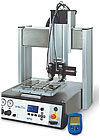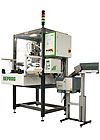
A fully integrated automated assembly line is a wonder to behold, but it’s not for everybody. Full automation is expensive and can be limiting in terms of the variety of products it can handle. Below a certain production threshold, full automation simply doesn’t make sense economically.
Fortunately, with the advent of affordable, easy-to-use robotics and linear motion technologies, it is becoming easier and easier to combine employees and a stand-alone automated system, or systems, in a single workcell. The resulting mixed-mode approach can help assemblers eliminate bottlenecks, improve quality and increase throughput. An automated workstation can also help a company create a healthier work environment by reducing the risk of repetitive stress injuries.

A number of equipment manufacturers offer tabletop Cartesian systems, like the Ultra TT dispensing systemfrom EFD Inc.
Dispensing
One of the areas that lend themselves most readily to stand-alone automation is dispensing. In addition to being highly repetitive, today’s dispensing applications require a level of precision that would have been unthinkable only a few years ago. Many gasketing applications, in particular, are simply beyond the ability of a human operator-nobody has as steady a hand as a robot.With this in mind, dispensing equipment manufacturer EFD Inc. (East Providence, RI) offers what it calls its Ultra TT line of tabletop Cartesian robots for dispensing everything from adhesives to lubricants in a wide range of assembly operations. In one case, a manufacturer is using the system to apply beads of silver-filled epoxy on the small circuit boards it produces for use in medical diagnostic equipment.
Previously, the company’s employees had been doing the job by hand. However, while the results were acceptable, each bead took 5 seconds to make, which was too long. Now an operator simply places a pallet with 50 fixtured workpieces on the robot work surface and pushes a button. The robot does the rest. Cycles times are now down to a single second per part.
Along these same lines, Sealant Equipment & Engineering Inc. (Plymouth, MI) recently worked with SPX Filtran SC (Des Plaines, IL) to create a robotic cell that bonds the metal end caps onto fabric filter elements in automotive filters. The system’s M-10iA six-axis robot from Fanuc Robotics America Inc. (Rochester Hills, MI) first dispenses a set amount of urethane adhesive into the filter end cap and then inserts the filters. After the first application of adhesive, the parts travel along a U-shaped dual-track conveyor so that they can cure for 15 minutes before a second adhesive application. In all, the cell accomplishes what it previously took two operators to do.
In another example of multitasking, Dispense Works Inc. (McHenry, IL) recently built a tabletop system for a pressure sensor manufacturer that both dispenses an adhesive and then carefully places a number of sensing chips into their individual housings with the help of machine vision.
In addition to locating both the chip and housing, the system places each chip to either a set pressure or position, based on the data gathered by the vision system. After the chips have been placed in their housings, an operator removes the assemblies for curing.
Finally, dispensing equipment manufacturer I&J Fisnar Inc. (Fair Lawn, NJ) offers what it calls its RT404-FLEXII series of tabletop, programmable rotary tables for dispensing circular patterns in hard-to-reach places, like those found in speaker assemblies. The company also integrates its valves and controllers with a number of different robot models, including SCARA and Cartesian robots.

This workcell drives anywhere from 87 to 256 screws, depending on the cell filter box assembly it is helping to manufacture. Photo courtesy Deprag Inc.
Automated Screwdriving
Another area that lends itself well to stand-alone automation is fastener installation. This is especially true of repetitive applications that require multiple fasteners driven to exact torque specs.Fastening equipment manufacturer Deprag Inc. (Lewisville, TX), for example, has created a number of stand-alone systems, including an automated cell that installs setscrews in filter boxes for cell towers.
The cell includes a two-station rotary-indexing table and automatically installs anywhere from 87 to 256 screws, depending on the exact filter box model. In operation, an employee loads one of the fixtures and then pushes a button to rotate the workpiece into the processing area. As it is installing the screws, the system logs the presence of any screws that fail to go in correctly, so that an operator can be immediately check and, if necessary, repair the defective assembly at a nearby workstation.
Two other companies with a long track record of building these kinds of systems are fastening equipment manufacturers Visumatic Industrial Products (Lexington, KY) and Design Tool Inc. (DTI-Conover, NC).
In addition to multi-spindle rotary indexing workstations, Visumatic also builds workstations that employ VIPer SCARA robots and machine vision. The latter both inspects the work in process and locates the necessary screw holes before the fasteners are inserted.
Among the many systems DTI has built over the years are both stand-alone Cartesian systems and a wide range of fixed, multi-spindle systems with part verifying capabilities. In the latter case, DTI will often include a two-station indexing table, which allows an operator to unload and load one fixture while the system is driving the fasteners in the other.
In the area of electronics manufacturing, Fancort Industries Inc. (West Caldwell, NJ) integrates screwdriving equipment with tabletop Cartesian or SCARA robots from Janome Industrial Equipment (Elk Grove Village, IL). The robots can be integrated with a number of different screwdriver types, depending on the precision required.

Repetitive tasks like the insertion of O-rings make excellent candidates for stand-alone automated assembly. Photo courtesy Amara Ohmann Ltd.
Pressing and O-Ring Insertion
In the area of pressing, Schmidt Technology (Cranberry Twp., PA) recently built a four-station hydro-pneumatic cell for swaging automotive lock assemblies. The system includes a four-station rotary indexing table with manual loading, part verification, pressing and automated unloading via a small pick-and-place system. The system accommodates multiple product types, and includes a number of color-coded parts fixtures to ensure the right fixture goes with the right model type. Production rates are 12 to 14 parts per minute.Another company specializing in stand-alone press systems is pressing and monitoring-equipment manufacturer Promess Inc. (Brighton, MI). Its line of customizable servo-press workstations employs the company’s electromechanical assembly press (EMAP) technology, which allows assemblers to generate a force-position signature for each pressing application, thereby creating a dynamic benchmark for in-line testing and “quality” assembly.
O-rings are another type of component that lends itself to automated installation, even in a mixed-mode environment. Alliance Plastics (Erie, PA), for example, is currently using an eight-station system from Automated Industrial Systems Inc. (Erie, PA) to first install the O-rings that go in one of its valve cap assemblies and then verify that the parts have been correctly installed.
The caps are fed to the system via a feeder bowl and track, after which a pick-and-place device places them in a fixture. The O-rings enter the system via a second feeder bowl, and a mechanical probe is used to automatically check for their presence after the caps pass through the insertion station.
Another company known for its automated O-ring insertion machines is Amara Ohrmann Ltd. (Cobourg, Ontario). Among the thousands of systems the company has built over the years has been a pair of semiautomatic benchtop systems that install O-rings on the valves of a water manifold assembly. Each valve stem requires four O-rings in all, one on each end and two on the circumference-a difficult assembly. Cycle times are under three seconds per valve.

Fanuc Robotics and welding equipment supplier Lincoln Electric are collaborating on what Lincoln Electric calls its eCell, a self-contained, two-station welding cell that is specifically designed to allow smaller fabricators to implement welding at minimal cost.
Machining and Welding
At its plant in Erwin, TN, Morrill Motors Inc. found it was having chronic problems with the milling station where it prepares its motor housings prior to assembly. Specifically, it found that the hand-loaded housings were not always oriented correctly. There were also a number of safety issues involved, because operators had to reach into the machine to load and unload the parts.To solve the problem, Morrill Motors installed an RX130 six-axis robot from Stäubli Robotics (Duncan, SC). Throughput has since increased 25 percent, raising part production from a low of 2,500 to a steady 3,700 parts a day.
Along these same lines, Fanuc Robotics and welding equipment supplier Lincoln Electric (Cleveland) are collaborating on what Lincoln Electric calls its eCell, a self-contained, two-station welding cell that is specifically designed to allow smaller fabricators to implement welding at minimal cost.
Featuring a Fanuc ArcMate 100iBe robot, the system can accommodate a wide range of welding technologies and is portable enough to be loaded into the back of a small truck. At one shop with just 16 employees, the eCell is used to help produce rollers used in the heavy-equipment industry.
Finally, Fancort Industries offers a number of SCARA and Cartesian systems that perform soldering operations on printed circuit boards and other components. In addition to storing multiple programs for use with a variety of model types, the systems can accommodate a number of different technologies, including noncontact microflame and laser soldering.


